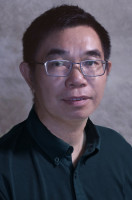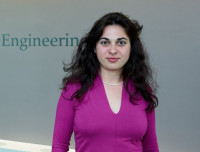Breaking the Vicious Circle Around Undocumented Migration
Dr. Ruben Andersson

Migration “Medicine” Makes the Patient Sicker
The Syrian crisis is currently of prime concern and, as in other conflict zones, there are questions about what is really happening in the region and how the world can intervene in a better way—“better”, because the current way isn’t working. Through ethnographic and field research, Dr. Andersson has examined the methods employed in an attempt to counter the flow of undocumented migration from Africa towards southern Europe. His findings insist on the fact that the approach taken by the EU and European states has been very counterproductive. “They treat the symptoms, but the medicine only makes things worse”, resulting in a vicious circle at the borders. The more that governments and the media fan the flames of migration drama in the Mediterranean, the more investments are made in border controls, in blocking migrants, monitoring their movements and building fences. But interviews with border guards show that these efforts only push migrants to turn to riskier routes and smuggling networks, all of which fuels more fear.
Dr. Andersson emphasizes that this is not just a question of states failing to manage migration, but a situation in which “the threat of migration is maintained, because there is no interest in stopping it.” The many players with a stake in the “medicine” being applied include agencies needing to justify their work during times of austerity; the private defense sector providing surveillance technology; smugglers who have become increasingly professionalized as a result of shifting migration routes; and neighboring countries that receive political and financial concessions from European governments. In Libya, this situation gave Gaddafi incentive to drum up trouble around migrants, Dr. Andersson explains, and the mistake is now being repeated in Turkey. “If we want to shift the dynamics, we need to look at the incentives. Recommendations may or may not be taken up, but we have to try and build momentum.”
Intervention in a No-Go Zone
Migration frequently drives the events underlying Dr. Andersson’s second research theme: how the world manages conflict and crisis zones. This might be through the deployment of peacekeepers, disbursement of funds, or launch of diplomatic missions. He is looking at the response to governmental and humanitarian crises, terrorism and, more particularly, conflict in Mali and the wider sub-Saharan Sahel region, a focus that was made possible by his grant from the AXA Research Fund.
When Jihadist groups extended into northern Mali, making it a no-go zone for Westerners, Dr. Andersson was forced to adapt his ethnographic methods to a situation that made his physical presence impossible—the same problem faced by the interveners he was studying in this high-risk region: humanitarian workers, peacekeepers, the UN. The question of how to engage under such circumstances thus became the starting point for his project. In Mali in 2014, Dr. Andersson conducted interviews with different groups to learn how they operate under the constraints of a conflict zone. He found that various parties—even humanitarian missions—act from a distance, using subcontractors or various kinds of technology to gain information and an understanding of these regions. He also concluded, though, that these measures can magnify the sense of remoteness of the conflict in question.
Taking a broader view on the phenomena he observes in Mali, he is also conducting comparative studies with other locations. In Afghanistan, security restrictions are leading to tensions when international aid workers are forced to stay “bunkered up”, instead of conducting their missions. A similar situation has been emerging in Mali since terror attacks in 2015. In Somalia, where the African Union is taking the lead in running a peace mission funded by international parties, Dr. Andersson is studying the “Africanization” of interventions. Unfortunately, he finds this division of labor is not as empowering as planned and can even be counterproductive. The African troops are underequipped and undertrained for dealing with terrorism, for example, leading to an Africanization of fatalities, too. Dr. Andersson is comparing the parallel problems faced by Somalia and Mali over the years. The theme as a whole is the subject of his forthcoming book, The Danger Zone.
Towards a More Humane Migration
This research program is sending a message to the research community about the need to understand, from the bottom up, responses to migration around the world and how migrants are interacting with interventions. The AXA Research Fund postdoctoral fellowship has allowed Dr. Andersson to establish his research program and his network, which includes top figures in migration policy at the UN and for the EU. This has left him well placed to make policy recommendations at the national and European levels for a broader, longer-term approach to migration strategy. With the important insight provided by his ethnographic approach, Dr. Andersson aims to contribute to alleviating conditions leading to forced migration in the face of violence or repression, as seen in Syria and Libya.
Dr. Andersson knows that achieving an impact on migration will be a complex, long-term process. The general public has a part to play in this, but is often extremely uninformed. He is helping to change that “drip by drip”, through publishing commentaries and giving interviews for major newspapers and media outlets, and on a website dedicated to his work. In fact, in his view, the most important impact of his work so far has been to help stimulate lasting public debate on specific issues around migration. He is grateful for the AXA Research Fund’s initiative to help its fellows gain skills for that very purpose. By participating in the AXA Pop Days science communication workshop, he was able to build a new skill set for reaching audiences outside the ivory tower.
With time, Dr. Andersson’s findings from the front lines of migration should make it possible to work against the vicious circle that exists between the drivers of undocumented migration toward southern Europe and the methods put in place to stop it. “Migration will keep happening,” he states simply. It has been a fact of life throughout human history and will only increase with the effects of development and of climate change. Through better understanding of its drivers, stakes, and the consequences of interventions, he hopes to help create alternatives to the current responses to different types of migration flows. “We have a choice of how humanely and rationally we organize it,” he says. “Today, in the European case, it is neither of those things.”
Discover Ruben's project
The risk crucible: managing multiple insecurities in the western Sahel
PROJECT PAGE
Discover research projects related to the topic
Financial & Social Inclusion
Finance
Culture & Society
Joint Research Initiative
China
Understanding the Financial Lives of Low Income Households in China
Leveraging financial diaries research methodology, this joint initiative aims to provide actionable insights about the financial lives of low-income households... Read more

Xiugen
MO

